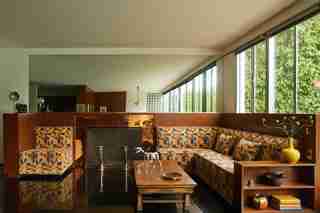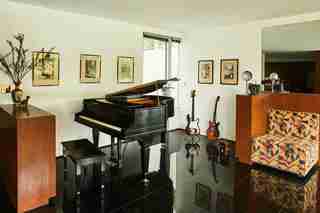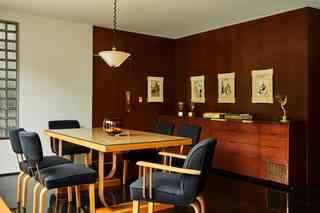When Academy Award–winning special effects innovator Richard Edlund bought his Richard Neutra –designed home in the fall of 1983, he knew it would take more than modeling clay and computer-generated imagery to bring the historic modernist property back to life.
After completing work on Return of the Jedi , Edlund decided to move back to Los Angeles from Marin County, where Industrial Light & Magic set up shop a few years earlier. He knew, right from the get-go, that he wanted to find an architecturally significant home. “I was thinking about Frank Lloyd Wright, Rudolph Schindler, and Neutra, hoping to find a house designed by one of them,” says Edlund, who enlisted the help of Crosby Doe, Southern California’s “über-agent” for architectural homes. “We toured several places—there was a tiny, hillside Wright house over in Silverlake that I considered, but it had tiny rooms and a few significant cracks. We also looked at a stunning Schindler property that was a bit too rickety.”
Eventually, the pair visited an overlooked Neutra masterpiece—hidden in plain sight—on a major thoroughfare in L.A.’s Holmby Hills neighborhood. “It was painted Pepto-Bismol pink and had a weird treatment on the roof that needed to be removed, so I got it for a steal,” he recalls. “There was actually a Neutra exhibition happening up the street, but the house was so ugly nobody paid any attention to it. Neutra must have been turning over in his grave.”
Built in 1937, the two-story, four-bedroom, four-bathroom home was originally designed for another film industry luminary: writer and producer Edward A. Kaufman. Known for cowriting the screenplay for MGM’s 1935 hit The Gay Divorcee , starring Ginger Rogers and Fred Astaire, Kaufman possessed a decorating style that arguably pales in comparison to his movie making, as evidenced by period photos. “It wasn’t one of Neutra’s favorite houses because of the way they treated it—installing valances with heavy draperies and Venetian-style blinds that blocked all the natural light,” says Edlund, a governor of the Academy of Motion Picture Arts and Sciences for over 20 years. He also speculates it’s the reason famed architectural photographer Julius Shulman —whose career Neutra ignited in 1936—never shot the home.
The second owner’s aesthetic was somewhat perplexing to Edlund, who began work on the house as soon as escrow closed. Ultimately, restoration of the almost 2,900-square-foot home took about six months and was an incredibly intense period for Edlund. “I rented a place south of Wilshire and would head over to meet the contractors in the morning, then drive to Marina del Rey—where I was working on Ghostbusters and building my visual effects studio—and back again to check in on the progress at night.” Every surface inside—and outside—the home had some issue to address. “Luckily, I had the original blueprints that included all of Neutra’s requirements, which made things easier.”
Although nearly all present, most of the key elements that exemplify a Neutra home—from the unique use of copper plating on the first level and chrome on the second story to the stylized rain gutters—had to be rehabbed. “I re-chromed and copper-plated all those elements,” he explains. “And, in order to match the original corrugated design of the gutters, I had to have them pre-engineered in Kansas City on the only machine in the country that could corrugate galvanized steel.” The exterior also received some much-needed attention and, thanks to input from Doe, was repainted in a shade of white typical of the architect’s style.
Incredibly, several pieces of the home’s original Neutra-designed furniture managed to survive the previous two residents. “I have the dining table and chairs, a barstool, desk chair, fireplace screen, and a few other pieces in impeccable condition.” All of the built-ins, including a copper-clad desk, Philippines mahogany-faced bookshelves, and banquette seating have also stood the test of time—with the “hideous” upholstery replaced by Clarence House Gropius and Samburu linen tapestry fabrics.
Over the years, Edlund made some very thoughtful improvements to the property—a swimming pool has replaced an asphalt slab, and the landscaping reflects his affinity for the artistry of Japanese gardens. “In the backyard, I have a macro bonsai that was trained by George Yamaguchi for 30 years before I planted it, and several other black pines from Tomoyuki Nakamura, [formerly of] the Imperial Palace Gardens in Tokyo.”
In 1987, for all his hard work, Edlund was recognized with a Los Angeles Conservancy Preservation Award for his “outstanding and meticulous restoration” of the home. And, in 1992—on what would have been Neutra’s 100th birthday—the house was chosen as the gathering spot for a party attended by the late architect’s family to celebrate the opening of “The Drawings of Richard Neutra: A Centennial Exhibition” at UCLA, curated by Thomas Hines. Not surprisingly, after nearly four decades as the property’s steward, it continues to be a passion project for him.
“Neutra may have produced a lot of work, but his sweet spot was really between 1929 and 1939,” Edlund avers. He adds: “People love this house—it’s much more livable than most of [his] homes.”

The living room showcases elements typical of a Neutra design including black granite floors, built-in seating (upholstered in Clarence House Gropius fabric), long bands of glass set in Truscon steel window frames, and the use of a large mirror to visually expand the space. Also typical was the architect’s use of copper plating on first-floor fixtures.

Black granite flooring, mahogany-faced bookshelves, and banquette seating extend throughout the home’s open floor plan.

The original Neutra-designed dining table and chairs survived the previous two homeowners.
A second formal living space in the front of the home functions as Edlund’s library and media room. The mahogany-faced built-in seating is upholstered in Clarence House Samburu linen tapestry fabric.
The built-in bar and original Neutra-designed barstool—within the library and media space—showcases copper elements that are typical of the architect’s homes from the period. Hard to find Lumiline bulbs, which Edlund describes as being “like gold,” illuminate the space. On display are Edlund’s Academy Awards, which he won for Star Wars films and for Indiana Jones .
The copper-plated, Neutra-designed built-in desk and original office chair are the focal points of the library. Edlund’s collection of rare Japanese prints is on display throughout the home.
“Kitchens were not Neutra’s forte,” Edlund says. The culinary workspace was redesigned with the architect’s aesthetic in mind, including clean lines and simple hardware.
A breakfast nook is located just off the kitchen.
With its black granite flooring, built-in cabinetry, bed frame, and large bays of windows, the already large primary bedroom appears much bigger. Throughout his career, Neutra was influenced by the contemporary heliotherapy movement and understood the importance of access to daily light.
A second-floor powder room features Neutra-specified chrome fixtures, Truscon steel windows, and black granite flooring.
Homeowner and Oscar-winning special effects innovator Richard Edlund and his partner Mara Sklar stand at the entrance to their 1937 Neutra-designed home in Holmby Hills.
The expansive backyard of the home includes a macro bonsai tree trained by George Yamaguchi and a swimming pool that replaced an asphalt slab. The exterior was repainted white.
